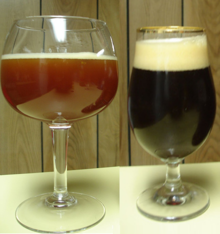– **History**:
– Bass No. 1 Ale was the first marketed as barley wine around 1870.
– Anchor Brewing introduced barley wine to the U.S. in 1976 with Old Foghorn.
– Sierra Nevada Brewing released Bigfoot Barleywine in 1983.
– Old Foghorn was labeled “barleywine” to avoid regulatory issues.
– Tennants introduced an amber barley wine in 1951.
– **Characteristics**:
– Barley wine has an alcohol strength of 6-12% and specific gravities up to 1.120.
– American barley wines are hoppier and more bitter.
– English barley wines are less bitter with more color variety.
– British barley wines were traditionally dark until Tennants’ Gold Label.
– Barley wines like Thomas Hardys Ale are intended for aging.
– **Taxes and Legal Impediments**:
– Barley wine is taxed higher due to its alcohol content in some jurisdictions.
– Barley wines often have a price premium compared to other beers.
– Regulations on where barley wines can be sold can lead to access limitations.
– **Wheat Wine**:
– Wheat wine is a variation of barley wine with added wheat in the mash bill.
– The style of wheat wine originated in the U.S. in the 1980s.
– **See Also**:
– List of barley-based beverages.
Barley wine (often stylised barleywine) is a strong ale from 6–12% alcohol by volume.
| Barley wine | |
|---|---|
 Barley wines range in colour from translucent deep amber, to cloudy mahogany (left), to near opaque black (right). | |
| Country of origin | England |
| Yeast type | Top-fermenting |
| Alcohol by volume | 6–12% |
| Color (SRM) | 8–22 (English) 10–19 (American) (24–48 EBC) |
| Bitterness (IBU) | 35–70 (English) 50–120 (American) |
| Original gravity | 1.080–1.120 |
| Final gravity | 1.018–1.030 (English) 1.016–1.030 (American) |
| Malt percentage | 100% |
